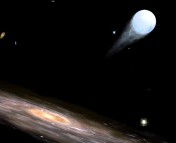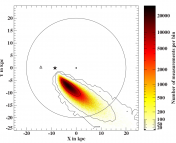Authors: Kohei Hattori, Monica Valluri, Norberto Castro, Ian U. Roederer, Guillaume Mahler, and Gourav Khullar
First Author’s Institution: University of Michigan
Status: Published in the Astrophysical Journal, preprint available on arXiv
Look at that unique runner!
Just like our Sun, most stars spend their entire lives in the Milky Way (MW). They follow certain trajectories orbiting the central supermassive blackhole (SMBH) in the galactic center. Coincidentally, humans are not the only ones with dreams of leaving home to see the world — so does a whole group of young and massive (O- and B-type) stars! These travelers are called hypervelocity stars (HVSs, Figure 1). Their velocities are on the order of 1000 km/s! Many HVSs are rebelliously running away from the gravitational influence of the SMBH towards the outside world, living out their short but extraordinary lives.
One particular runner, LAMOST-HVS1, stands out with its “super speed” as determined by its spectra. LAMOST-HVS1 is a subgiant star with a mass of 8.3 solar-masses and is currently running away at a total speed of 553 km/s, five times higher than the fastest rocket (NASA’s Juno spacecraft)! In today’s paper, the authors used Gaia data (Gaia Collaboration et al. 2018) to explore the origin of this special runaway star’s “super speed”.
Exploring a life-long story of the “fast and furious”
In order to understand LAMOST-HVS1’s present behavior, the authors need to reconstruct its long journey from home.
While most HVSs gain their high speed after being ejected by the SMBH at the Galactic Center, this mechanism does not apply to LAMOST-HVS1. With high-precision observations of LAMOST-HVS1 from Gaia, the authors found that its proper motion falls out of the range of general HVSs (Figure 2, Hattori et al., 2018b). Therefore, this super runner is more likely boosted by an ejection from the stellar disk rather than the SMBH. This makes LAMOST-HVS1 a unique star with important information about the extreme environments that result in massive star ejection.
In order to reconstruct the star’s ejection, the authors first derived an age estimate for LAMOST-HVS1 from spectroscopic modeling and fitting, arriving at 37 Myr. This time frame provides an upper limit for the star’s traveling time between the ejection location and its current position. Then, given the star’s current dynamics, the authors used a Monte Carlo approach to reconstruct all possible original orbital properties from 1 million sets of position-velocity in three dimensions. From there, the authors examined the probability distribution of all scenarios of the ejection. From the scenarios with higher probability, the authors could infer what happened to LAMOST-HVS1 before.
Finally, the authors were able to tell the story of LAMOST-HVS1: the star was born in the high-density environment of the inner galactic disk 37 Myr ago. Early in its childhood, LAMOST-HVS1 interacted with much more massive stars or even an intermediate mass black hole, accumulating a large amount of kinetic energy. Once it had enough kinetic energy to escape the gravitational pull of its environment, it started its rapid journey towards the extragalactic world, and hasn’t looked back! Since then, it has been on the road for 33 Myr and has barely slowed down. LAMOST-HVS1 is the first well-confirmed early B-type HVS with an incredible initial velocity (around 600 km/s ejected from the inner Galactic disk). What a “fast and furious” star!
Where is the star’s original home?
Since the ejection location points towards the Norma spiral arm, the authors tried to find a more specific home address for LAMOST-HVS1. Young massive stars like LAMOST-HVS1 tend to be born together in a crowded environment like the core of a young massive clusters (YMC). However, none of the known YMCs in that area match the properties of LAMOST-HVS1 so far. The natal home of the amazing LAMOST-HVS1, wherever that is, may be an undiscovered YMC, hiding behind heavy dust with all the sibling stars of this super runner of the MW.




